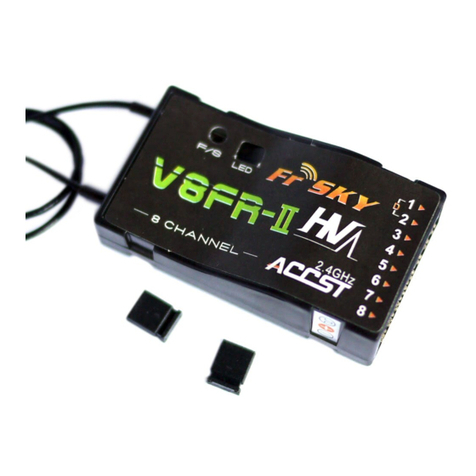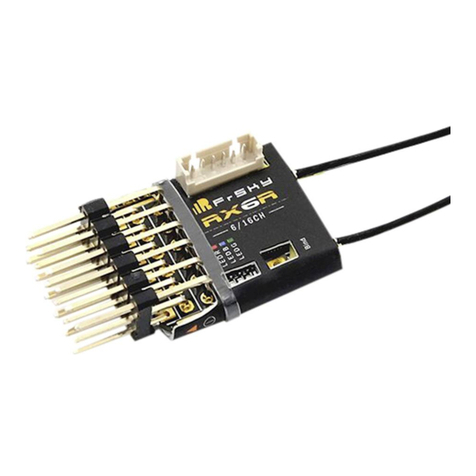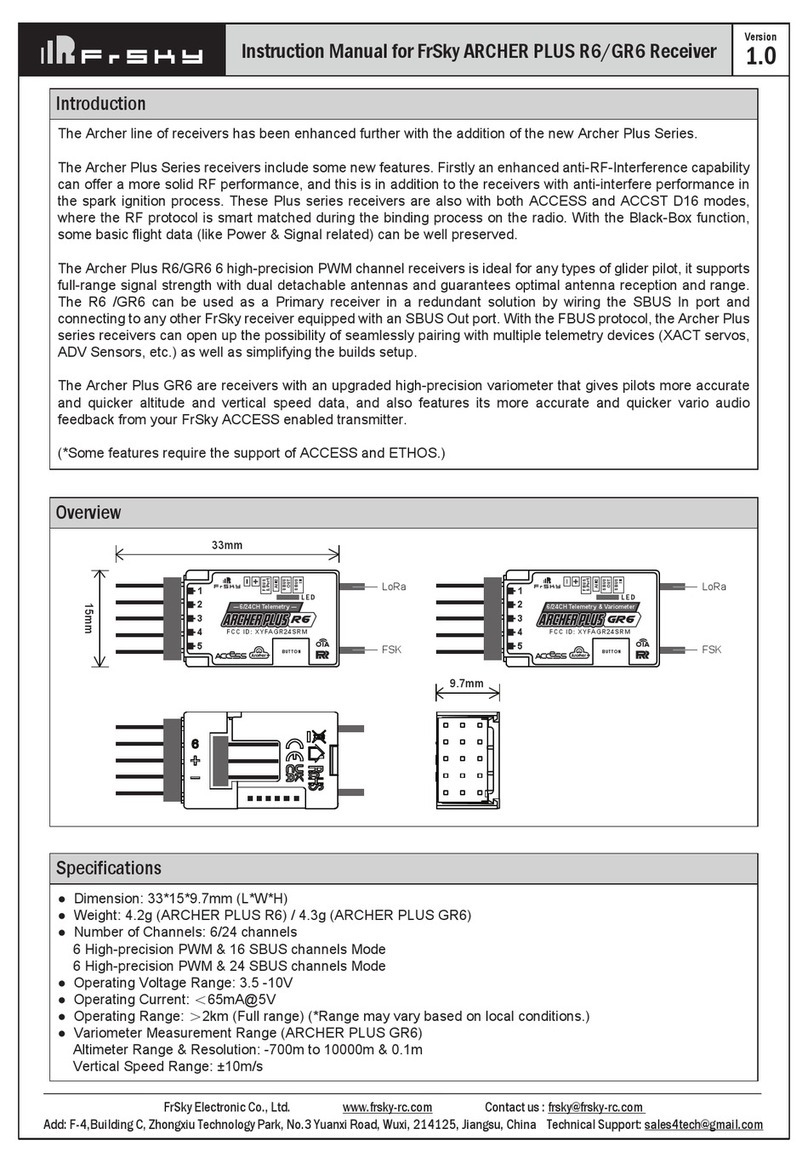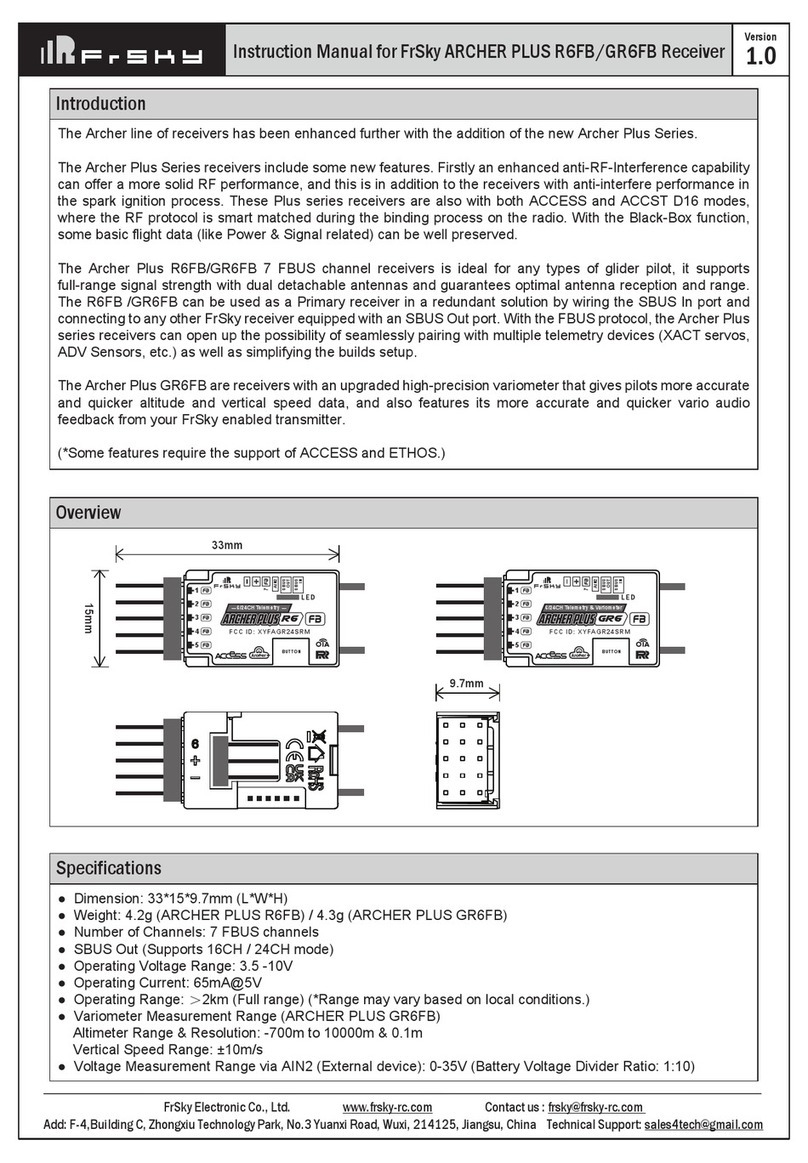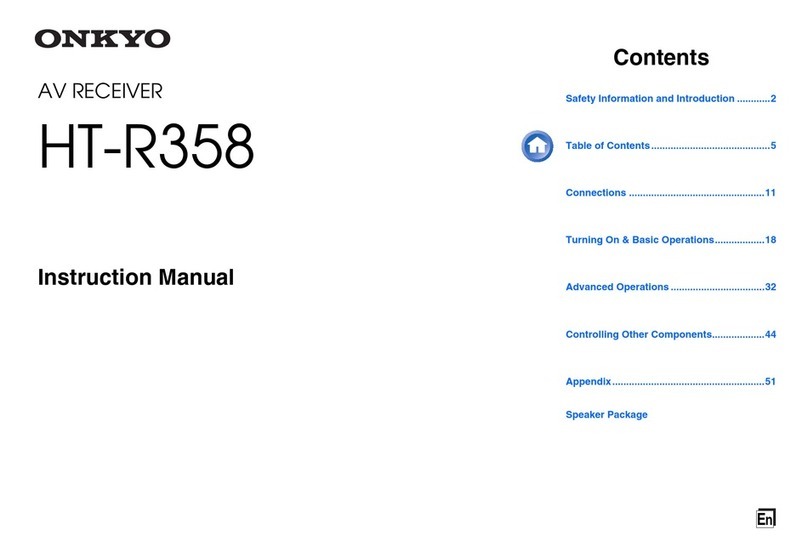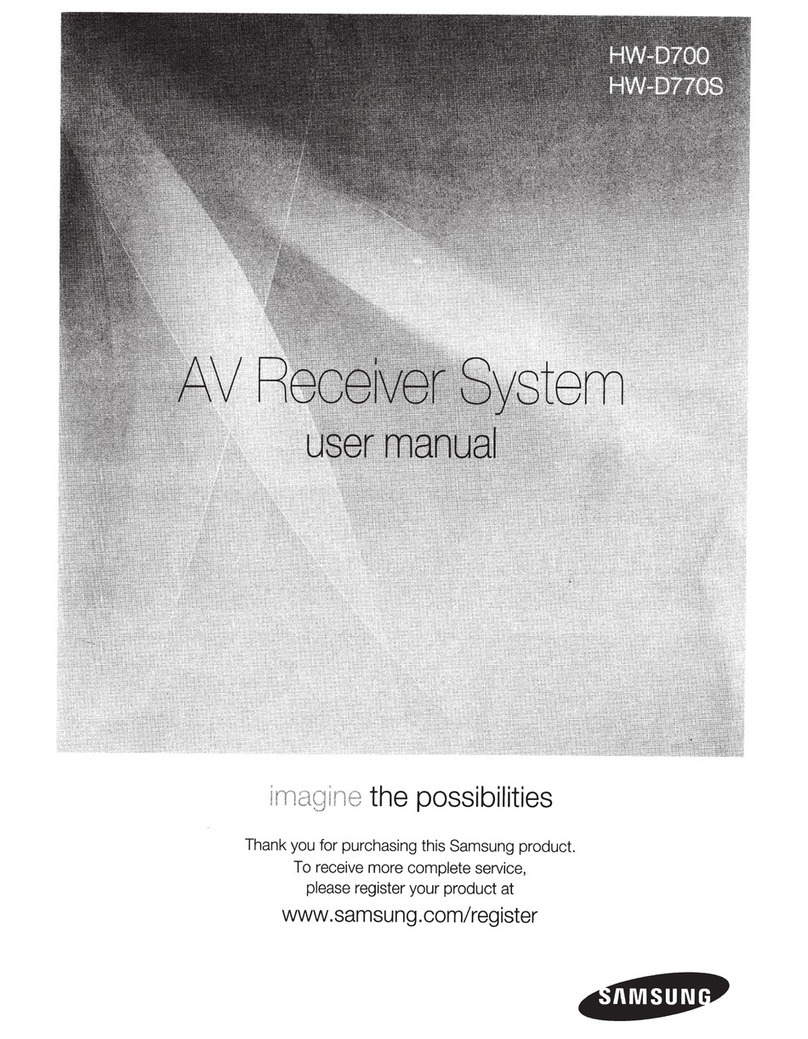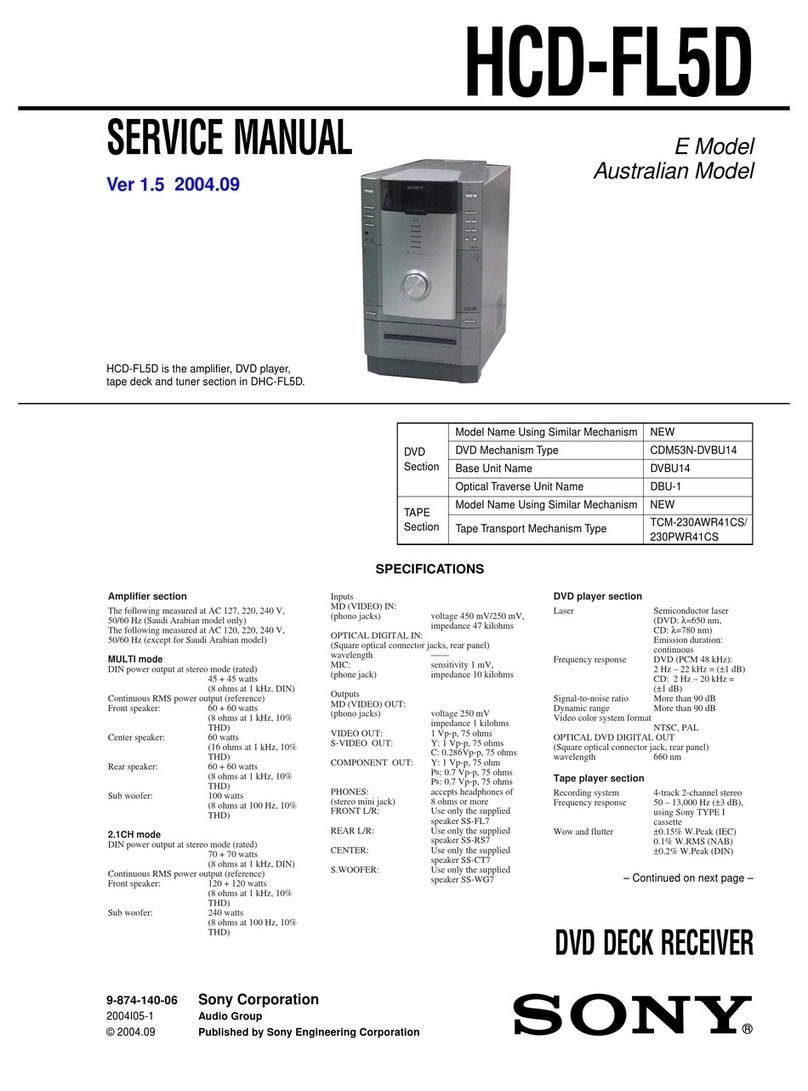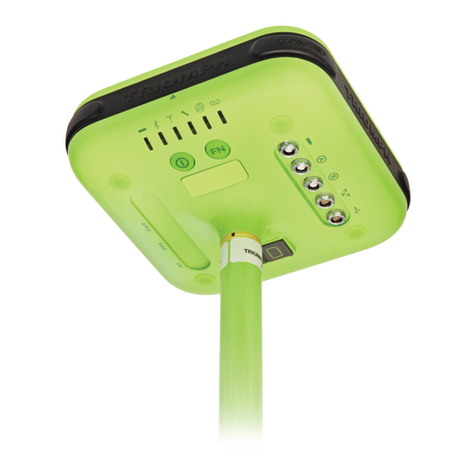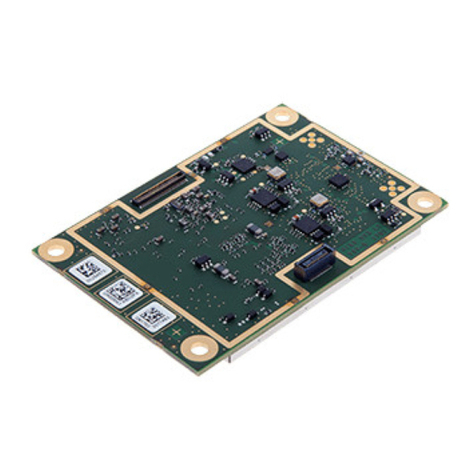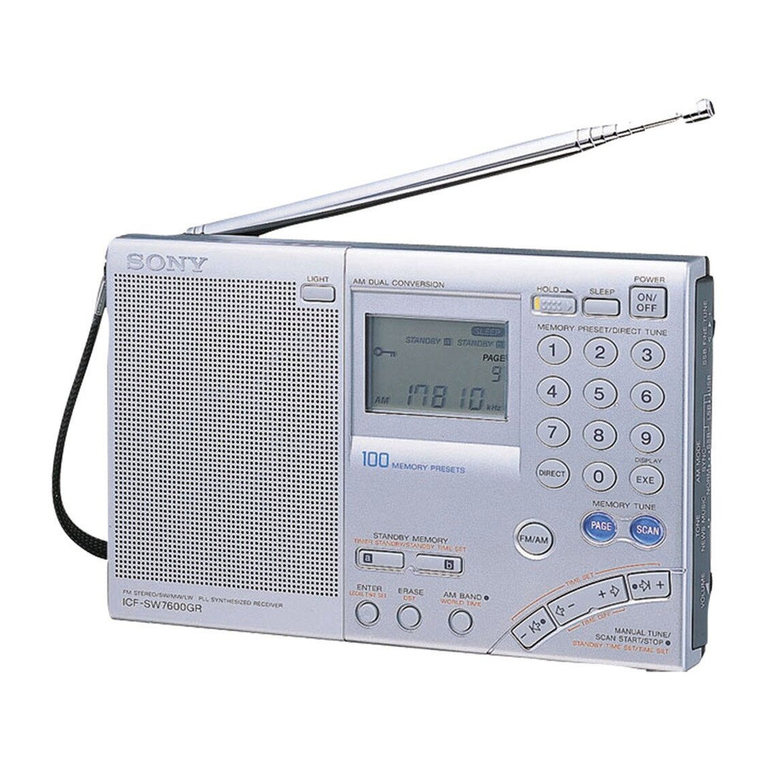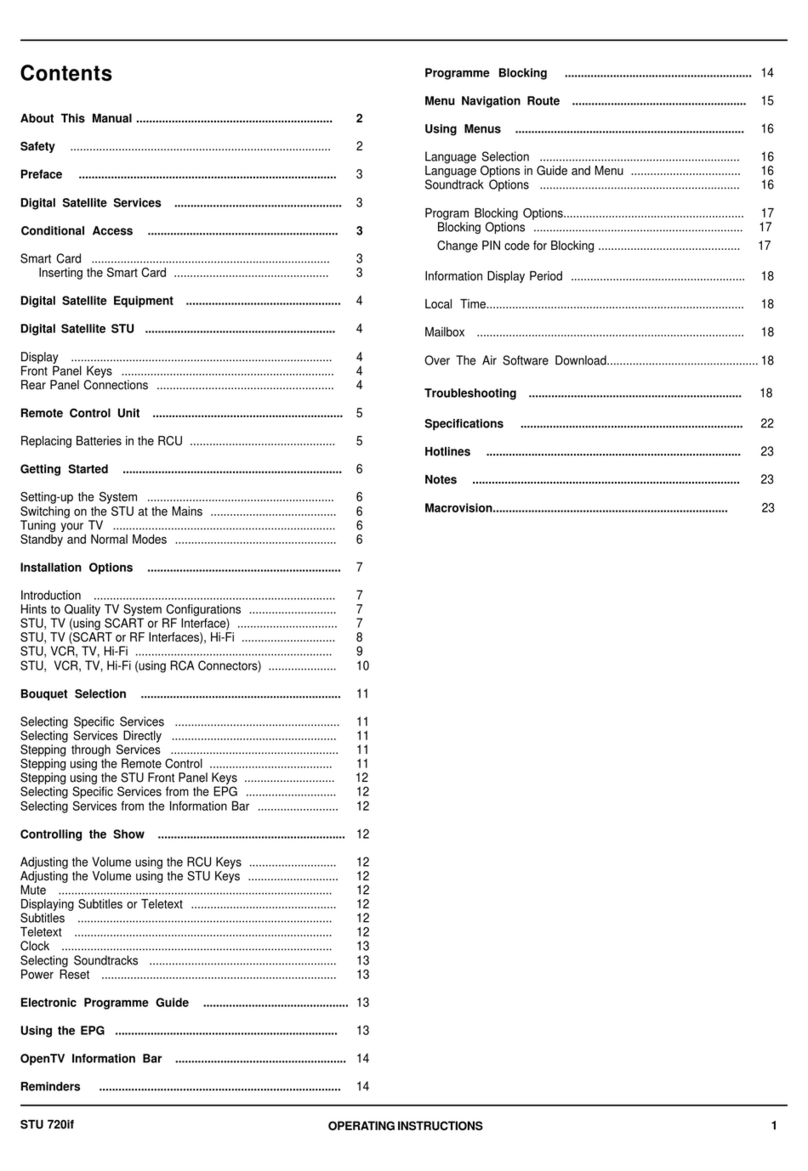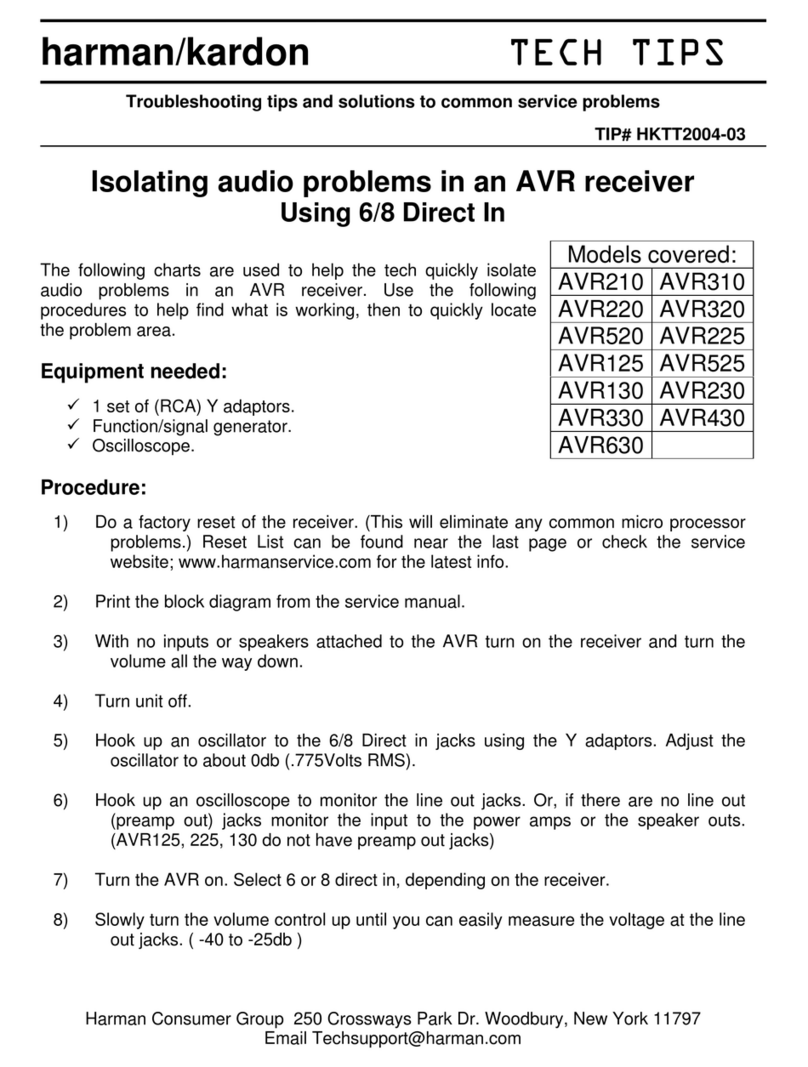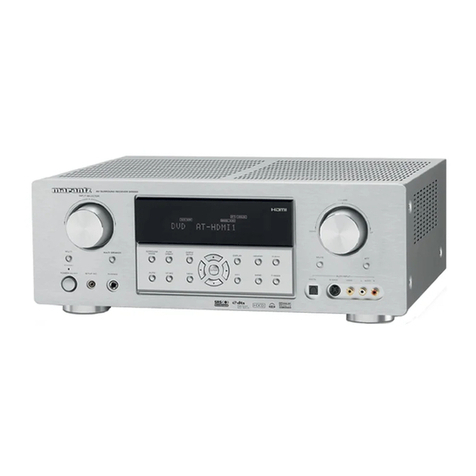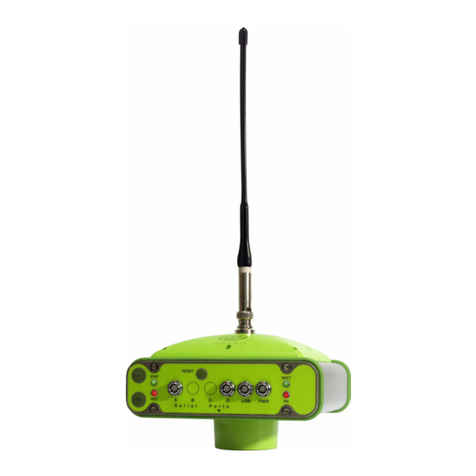FrSky HORUS X10S User manual

FrSky 2.4GHz ACCESS Horus X10 Express/Horus X10S Express Manual
Add: F-4,Building C, Zhongxiu Technology Park, No.3 Yuanxi Road, Wuxi, 214125, Jiangsu, China Technical Support: [email protected]
FrSky 2.4GHz ACCESS Horus X10 Express/Horus X10S Express Manual
Add: F-4,Building C, Zhongxiu Technology Park, No.3 Yuanxi Road, Wuxi, 214125, Jiangsu, China Technical Support: [email protected]
FrSky 2.4GHz ACCESS Horus X10 Express/Horus X10S Express Manual
Add: F-4,Building C, Zhongxiu Technology Park, No.3 Yuanxi Road, Wuxi, 214125, Jiangsu, China Technical Support: [email protected]
FrSky 2.4GHz ACCESS Horus X10 Express/Horus X10S Express Manual
Add: F-4,Building C, Zhongxiu Technology Park, No.3 Yuanxi Road, Wuxi, 214125, Jiangsu, China Technical Support: [email protected]
Cautions on handling External antenna.
Do not touch the antenna during operation. Doing so could interfere with transmission, causing a crash.
Do not carry the transmitter by the antenna. The antenna wire could break and prevent transmission.
Do not pull the antenna forcefully. The antenna wire could break and prevent transmission.
Specifications
●
Dimension: 213*225*112 mm (L*W*H)
●
Weight: Horus X10 Express: 900g (without battery)
Horus X10S Express: 950g (without battery)
●
Operating system: FrOS / OpenTX
●
Internal RF module: ISRM-S-X10E
●
Number of Channels: 24 channels
●
Operating Voltage Range: 6.5 ~ 8.4V (2S Li-battery)
●
Operating Temperature: -10℃~60℃(14℉~140℉)
●
●
Charging Current: ≤1A ±200mA
●
USB Adaptor Voltage: 5V+0.2V
●
USB Adaptor Current: >2.0A
●
Backlit LCD resolution: 480*272
●
Compatibility: ACCST D16 and ACCESS receivers
Micro SD Card slot
External RF Module slot
Introduction
With the demand for further extending the legacy of the Horus Series Transmitters, the Horus X10/S Express version
was born. With many new updates like applying the ACCESS protocol and hardware tweaks.
Horus X10/S Express use the ACCESS communication protocol, it boasts 24 channels with a faster baud rate and
lower latency equipped with a high-speed module digital interface. Along with the new spectrum analysis function and
added FrOS/OpenTX firmware, it is now possible to check the airwaves for RF noise.
Both X10 and X10S Express support balancing charge for 2S Li-ion battery via a collateral USB cable. The accessible
battery compartment design is another change worth mentioning, with two 18650 Li-ion batteries you can expect to be
able to fly all day. The Express carries forward all of their predecessor’ features like the industrial LCD color screen,
and the highly-accuracy M10/MC12P hall sensor gimbals which offer the most precise control. Additionally, it features
a remarkable PARA wireless trainer function which also makes them compatible with the FrSky Free Link App and
AirLink S. All that makes the Express version an ideal transmitter for, gliders, helis, multirotor and every type of
fixed-wing imaginable.
Mini USB Port
Features
●
High-speed module digital interface with installed
ACCESS protocol
●
Supports spectrum analyzer function
●
Supports wired training function
●
New PARA wireless training system
- High-speed training system with a lower latency
- Compatible with FrSky Free Link App and AirLink S
via mobile devices
●
Dual internal antennas and a single detachable external
antenna work in unison to create a robust link
●
Antenna detection and SWR warning
●
Industrial LCD: 480*272 readable outdoor color screen
●
Supports 2S Li-battery balancing charge with mini USB
interface
●
Easily accessible battery compartment (*Batteries not
included)
●
M10 hall sensor gimbals and extendable stick ends
(Horus X10 Express)
●
MC12P all CNC digital higher accuracy ten bearings hall
sensor gimbals and extendable stick ends (Horus X10S
Express)
Note:
1. Charge the battery with the USB adapter
(Voltage:5V+0.2V Current:>2.0A) when
you use the USB charging function.
2. The lower the initial charging voltage, the
better the charging effect is when the
voltage difference between the two cells
exceed 50 mV.
LiFePO battery is not supported.
Battery compartment size: 76*36.5*18.6mm(L*W*H)
Notes and Warnings for Battery & Charger
About USB 2S Li-battery balance charging :
The Green Power indicator LED state:
Led on: charging Led off: charge end Led flash: charge fault
Please use the following type of battery if you do not want to use the battery slot.
PH2.54-XH-3Y
Battery +
Battery Balance
Battery -
Olny 2S Li-Ion/Li-Po battery
4
01140108 01140108
0114010801140108
Overview
(Switch Default Settings)
● SA: 3 positions, Short Lever
● SB: 3 positions, Long Lever
● SC: 3 positions, Long Lever
● SD: 3 positions, Short Lever
● SE: 3 positions, Short Lever
● SF: 2 positions, Long Lever
● SG: 3 positions, Short lever
● SH: 2 positions, Momentary;
Long Lever
+X
+Y
+Z
SMA Connector
Infinity 24 Antenna
Recommended 2.4GHz optional high-gain antenna for
achieving higher performance and further range.
You can choose the Switch and define its positions in the
Input and Output Map screen.
1. Micro SD card is not provided with shipment.
2. USB port is for upgrading, reading/writing Micro SD cards
and internal memory of radio contents and charging (Includes
USB cable in packge but without the adapter).
3. Smart Port is for firmware upgrade for all FrSky S.Port
devices.
Model Setup Procedure-Internal Module
Step 1:
Use the navigation keys to enter the RF system menu.
Choose the INT MODULE. Then turn ON INTERNAL RF, select the OUTSIDE or INSIDE ANTENNA.
Set the Mode for Horus X10 Express/Horus X10S Express internal RF corresponding to your receiver (ACCESS,
ACCST D16).
Step 2:
Configure the model channel and create the model name.
Create the model
Step 1:
First go to System Settings, then select model select click the plus sign to select model type.
ETHOS Operating System
Step 2:
Set the Channel Range
The ISRM module supports 24 channels. the channel range is configurable, and it needs to be double checked
before use.
Step 5:
Automatic binding (Smart Match )
Move the cursor to Rx1[BIND],and select it, power your receiver, select the RX, and complete the process, the
system will confirm "Bind succeed". (Pressing the "F/S" button is not required in ACCESS to Bind. Please the
receivers manual for details).
Step 3:
Set the Receiver Number
The system will assign you the receiver a number
automatically, when you create a new model, and this
can be easily changed. The range of the Model ID is
00-63, with the default number being 01. Once the
receiver is set to the desired number and is bound to the
Horus X10 Express/Horus X10S Express, the bind
procedure will not need to be repeated unless the
receiver number is changed. At this point, set the
receiving number to your preferred number and repeat
the binding operation.
Step 4 :
Registration
In ACCESS model, select the STATE [Register] into Registration status on radio side. Then Press the F/S button
and power on your receiver, and select the “RX Name XX” and [REGISTER] to complete the Registration process
then power down the receiver.

FrSky 2.4GHz ACCESS Horus X10 Express/Horus X10S Express Manual
Add: F-4,Building C, Zhongxiu Technology Park, No.3 Yuanxi Road, Wuxi, 214125, Jiangsu, China Technical Support: [email protected]
01140108
FrSky 2.4GHz ACCESS Horus X10 Express/Horus X10S Express Manual
Add: F-4,Building C, Zhongxiu Technology Park, No.3 Yuanxi Road, Wuxi, 214125, Jiangsu, China Technical Support: [email protected]
01140108
FrSky 2.4GHz ACCESS Horus X10 Express/Horus X10S Express Manual
Add: F-4,Building C, Zhongxiu Technology Park, No.3 Yuanxi Road, Wuxi, 214125, Jiangsu, China Technical Support: [email protected]
01140108
FrSky 2.4GHz ACCESS Horus X10 Express/Horus X10S Express Manual
Add: F-4,Building C, Zhongxiu Technology Park, No.3 Yuanxi Road, Wuxi, 214125, Jiangsu, China Technical Support: [email protected]
Updates
FrSky is continuously adding features and improvements to our radio systems. Updating (via the Micro SD card in
Horus X10 Express/Horus X10S Express Micro SD Card Slot
) is easy and free. To get the most from your new
transmitter, please check the download section of the FrSky website www.frsky-rc.com, for the latest update
firmware and how-to guide.
Horus X10 Express/Horus X10S Express
installed the FrSky FrOS operation system. Do not hesitate to contact
FrSky if you have ideas and suggestions for current and future radio systems, or if you are willing to join the FrSky
developing union to be part of future projects.
The currently pre-installed firmware of
Horus X10 Express/Horus X10S Express is
FrSky FrOS firmware, developed
and well tested by FrSky. The transmitter also supports the open source OpenTX firmware.
More information about OpenTX can be found on: http://openrcforums.com.
Li-Ion Battery Safety and Handling instructions
It’s important to understand the operating characteristics of Li-Ion battery. Read the specifications printed on the
label of your Li-Ion battery and charger prior to use. Failure to follow the these precautions can quickly result in
severe, permanent damage to the battery and its surroundings and possibly result in a FIRE!
Do not leave a Li-Ion battery unattended at any time while being charged or discharged.
Do not attempt to charge Li-Ion batteries with a charger that is NOT designed for Li-Ion batteries, as permanent
damage to the battery and charger could result.
Always charge Li-Ion batteries in a fireproof location. Do not charge or discharge Li-Ion batteries on carpet, a
cluttered workbench, near paper, plastic, vinyl, leather or wood, or inside an R/C model or full-sized automobile!
Monitor the charge area with a smoke or fire alarm.
Do not charge Li-Ion battery at currents greater than the “1C” rating of the battery (“C” equals the rated capacity
of the battery).
Do not allow Li-Ion cells to overheat at any time! Cells which reach greater than 140 degrees Fahrenheit (60°C)
should be placed in a fireproof location.
Li-Ion cells will not charge fully when too cold or show full charge.
It is normal for the batteries to become warm during charging, but if the charger or battery becomes excessively
hot disconnect the battery from the charger immediately!! Always inspect for potential damage any battery
which has previously overheated for potential damage, and do not re-use if you suspect it has been damaged
in any way.
Do not use a Li-Ion battery if you suspect physical damage has occurred to the pack. Carefully inspect the
battery for even the smallest of dents, cracks, splits, punctures or damage to the wiring and connectors.
DO not allow the battery’s internal electrolyte to get into eyes or on skin—wash affected areas immediately
if they come in.
IMPORTANT PRECAUTIONS
IMPORTANT! The Li-Ion battery are not to be confused with any other type of rechargeable battery (including
NiCd and LiFe). Li-Ion batteries require special charging criteria different than other rechargeable batteries.
01140108
Where to Fly
We recommend that you fly at a recognized model airplane flying field. You can find model clubs and fields
by asking your nearest hobby dealer.
Always pay particular attention to the flying field’s rules, as well as the presence and location of
spectators, the wind direction, and any obstacles on the field. Be very careful flying in areas near power lines,
tall buildings, or communication facilities as there may be radio interference in their vicinity.
At the flying field
To prevent possible damage to your radio gear, turn the power switches on and off in the proper sequence:
1. Pull throttle stick to idle position, or otherwise disarm your motor/engine.
2. Turn on the transmitter power and allow your transmitter to reach its home screen.
3. Confirm the proper model memory has been selected.
4. Turn on your receiver power.
5. Test all controls. If a servo operates abnormally, don’t attempt to fly until you determine the cause
of the problem. (For PCM systems only: Test to ensure that the Failsafe settings are correct by
waiting at least 2 minutes after adjusting then, turning the transmitter off and confirming the proper
surface/throttle movements. Turn the transmitter back on.)
6. Start your engine.
7. Complete a full range check.
8. After flying, bring the throttle stick to idle position, engage any kill switches or otherwise disarm
your motor/engine.
If you do not turn on your system on and off in this order, you may damage your servos or control surfaces,
flood your engine, or in the case of electric-powered or gasoline-powered models, the engine may unexpect-
edly turn on and cause a severe injury.
Make sure your transmitter can’t tip it over. If it is knocked over, the throttle stick may be accidentally
moved, causing the engine to speed up. Also, damage to your transmitter may occur.
In order to maintain complete control of your aircraft it is important that it remains visible at all times. Flying
behind large objects such as buildings, grain bins, etc. must be avoided. Doing so may interrupt the radio
frequency link to the model, resulting in loss of control.
Do not grasp the transmitter's antenna during flight. Doing so may degrade the quality of the radio frequency
transmission and could result in loss of control.
As with all radio frequency transmissions, the strongest area of signal transmission is from the sides of
the transmitter's antenna. As such, the antenna should not be pointed directly at the model. If your flying style
creates this situation, easily move the antenna to correct this situation
Before taxiing, be sure to extend the transmitter antenna to its full length.
A collapsed antenna will reduce your flying range and cause a loss of control. It is a good idea to avoid
pointing the transmitter antenna directly at the model, since the signal is weakest in that direction.
Don’t fly in the rain! Water or moisture may enter the transmitter through the antenna or stick openings
and cause erratic operation or loss of control. If you must fly in wet weather during a contest, be sure to cover
your transmitter with a plastic bag or waterproof barrier. Never fly if lightning is expected.
Stop flying long before your batteries become low on charge. Do not rely on your radio’s low
battery warning systems, intended only as a precaution, to tell you when to recharge. Always
check your transmitter and receiver batteries prior to each flight.
FCC Statement
Changes or modifications not expressly approved by the party responsible for compliance could void the user's
authority to operate the equipment.
NOTE: This equipment has been tested and found to comply with the limits for a Class B digital device,
pursuant to Part 15 of the FCC Rules. These limits are designed to provide reasonable protection against
harmful interference in a residential installation.
This equipment generates uses and can radiate radio frequency energy and, if not installed and used in
accordance with the instructions, may cause harmful interference to radio communications.
Make sure you set the country code to your corresponding country to match the regulations.
However, there is no guarantee that interference will not occur in a particular installation. If this equipment does
cause harmful interference to radio or television reception, which can be determined by turning the equipment off
and on, the user is encouraged to try to correct the interference by one or more of the following measures:
- Reorient or relocate the receiving antenna.
- Increase the separation between the equipment and receiver.
- Connect the equipment into an outlet on a circuit different from that to which the receiver is connected.
- Consult the dealer or an experienced radio/TV technician for help.
RF warning statement:
The device has been evaluated to meet general RF exposure requirement. The device can be used in portable
exposure condition without restriction.
CE
The product may be used freely in these countries: Germany, UK, France,Italy, Spain, Belgium, Netherlands,
Portugal, Greece, Ireland, Denmark, Luxembourg, Austria, Finland, Sweden, Norway and Iceland.
FLYING SAFETY
Warning:
To ensure the safety of yourself and others, please observe the following precautions.
Have regular maintenance performed. Although your Horus X12S protects the model memories with
non-volatile EEPROM memory (which does not require periodic replacement) and of a battery, it still
should have regular check-ups for wear and tear. We recommend sending your system to your FrSky
Service Center annually during your non-flying-season for a complete check-up and service.
Battery
Charge the batteries! Using the standard Horus battery and charger, always recharge the transmitter
and receiver batteries for at least 8 hours before each flying session. A low battery will soon die, causing
loss of control and a crash. When you begin your flying session, reset your transmitter’s built-in timer, and
during the session pay attention to the duration of usage. Also, if your model uses a separate receiver
battery, make sure it is fully charged before each flying session.
Model Setup for Horus X10 Express/Horus X10S Express External RF Module
The external RF module can be powered on or off by
software. The setup process is the same as that for the
internal RF. External modules should be closed when
not in use.
Step 6:
Set Failsafe mode
There are 3 failsafe modes when enable: No Pulse, Hold, Custom.
Then rotate the Encoder to set your failsafe for each channel and short press Encoder to finish the setting. Wait 9
seconds before the failsafe takes effect.
Notice:
● When failsafe is disabled on
Horus X10 Express/Horus X10S Express
side, the failsafe set on receiver side will
be used.
● SBUS port does not support the No Pulse failsafe mode and always outputs. Set “Hold” or “Custom” for SBUS
port.
●
No Pulse: on loss of signal the receiver produces no
pulses on any channel. To use this type, select it in the
menu and wait 9 seconds for the failsafe to take effect.
● Hold: the receiver continues to output the last
positions before signal was lost. To use this type, select
it in the menu and wait 9 seconds for the failsafe to take
effect.
● Custom: pre-set to required positions on lost signal.
Move the cursor to the failsafe mode of channel and
press
Encoder, then choose the Custom mode. Move the
cursor to the channel you want to set failsafe on, and
press Encoder.
Step 7:
Range
Range refers to
Horus X10 Express/Horus X10S Express
range check mode. A pre-flight range check should be
done before each flying session. Move the cursor to “STATE”, scroll the Encoder to select “RANGE” mode and
press Encoder. In range check mode, the effective distance will be decreased to 1/30. Press the Encoder again, turn
to normal state.
Other manuals for HORUS X10S
2
This manual suits for next models
1
Other FrSky Receiver manuals
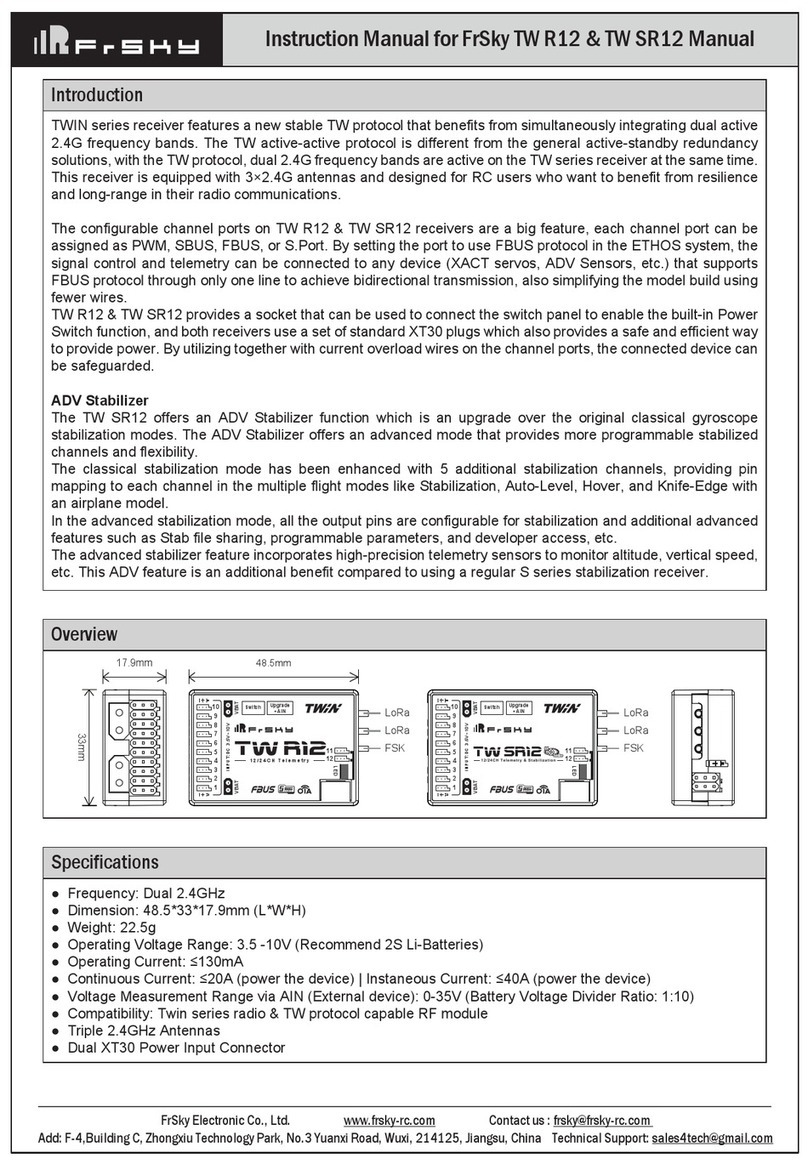
FrSky
FrSky TWIN Series User manual
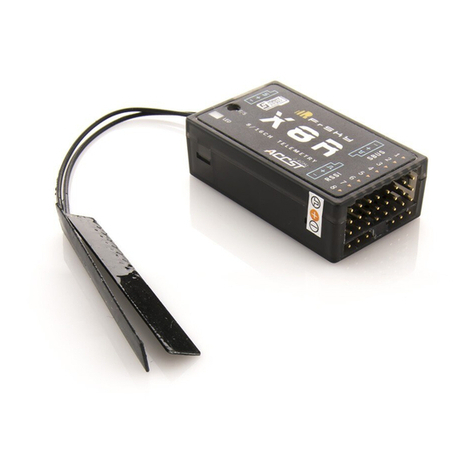
FrSky
FrSky X8R User manual
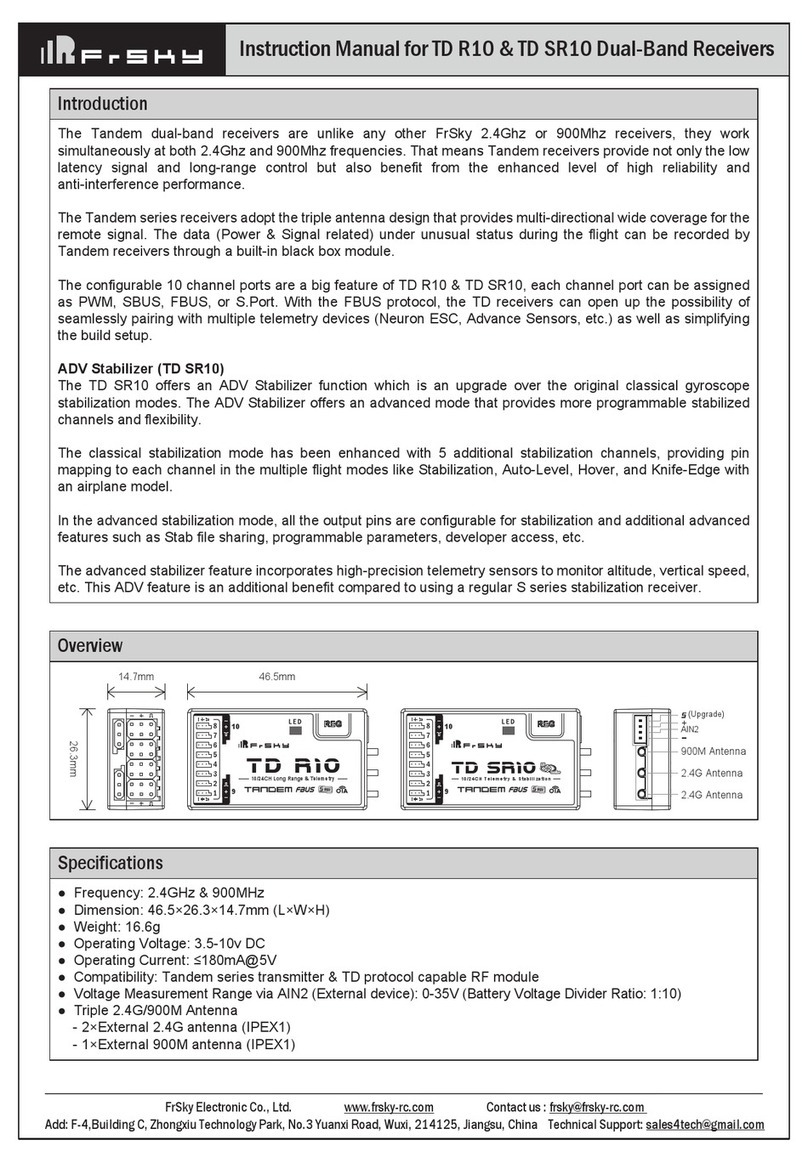
FrSky
FrSky TD SR10 User manual
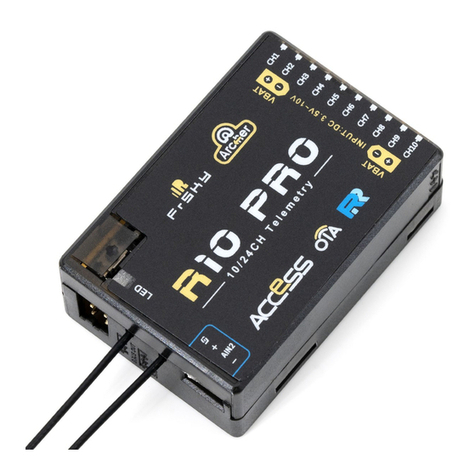
FrSky
FrSky Archer R10 Pro User manual
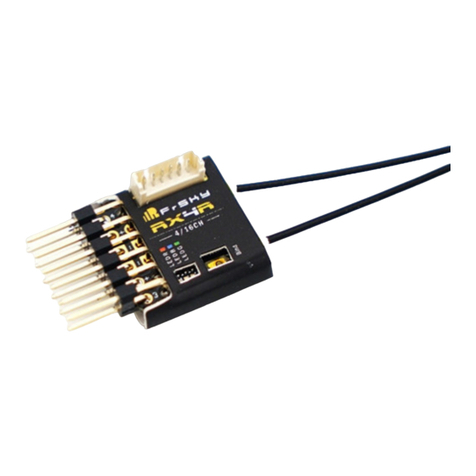
FrSky
FrSky ACCESS RX4R User manual
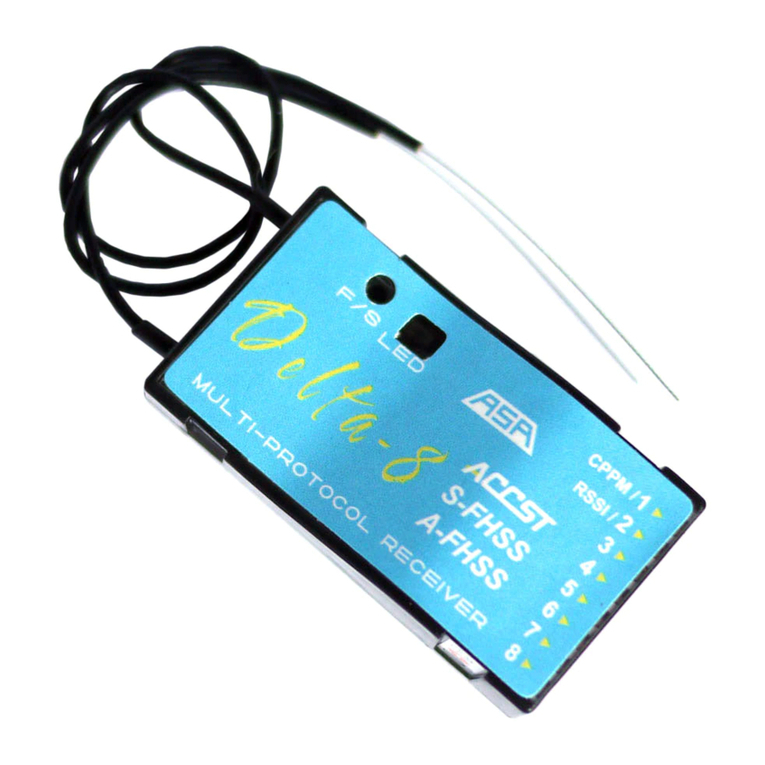
FrSky
FrSky Delta 8 User manual
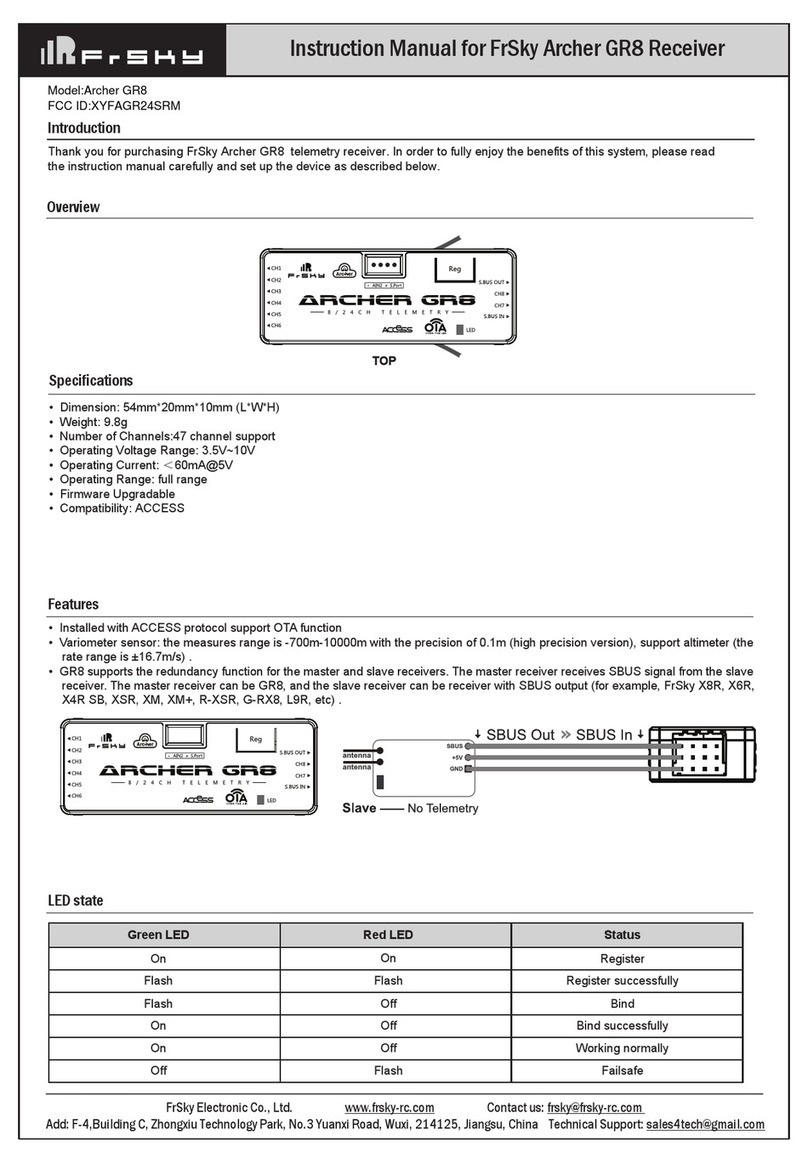
FrSky
FrSky Archer GR8 User manual

FrSky
FrSky Delta 8 User manual

FrSky
FrSky R9 User manual
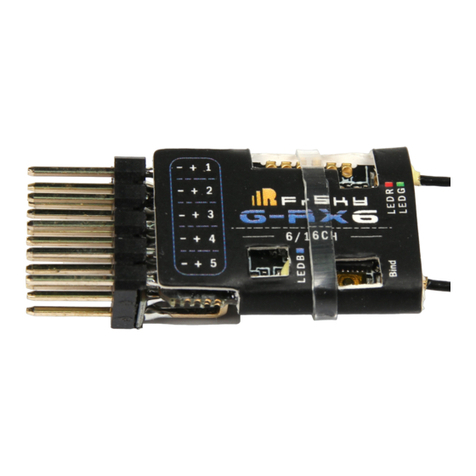
FrSky
FrSky ACCST G-RX6 User manual

FrSky
FrSky X4R-SB User manual
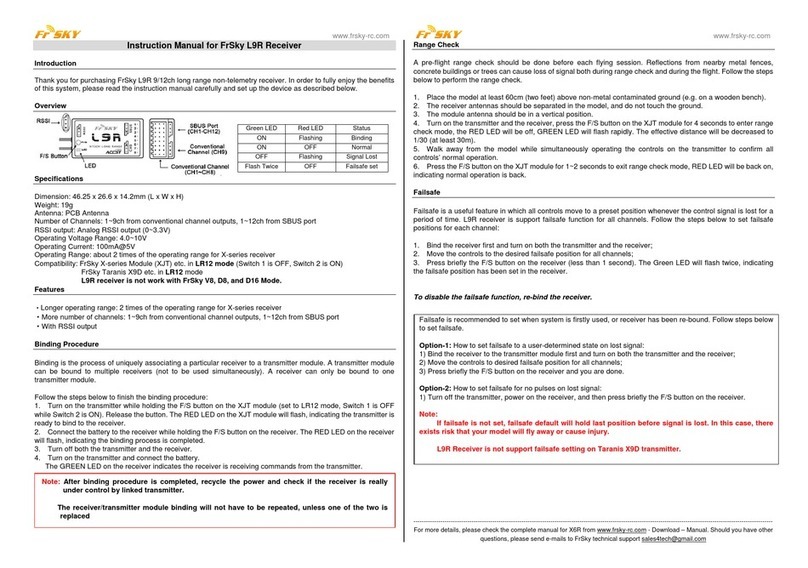
FrSky
FrSky L9R User manual
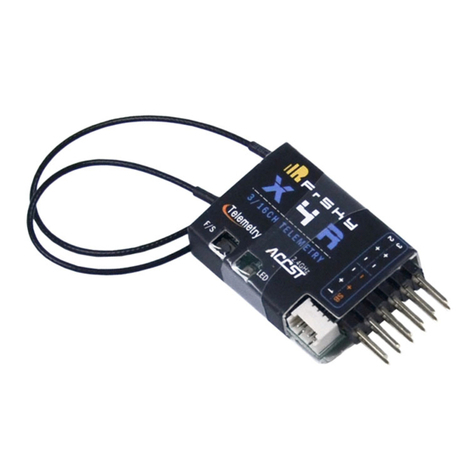
FrSky
FrSky X4R-SB User manual
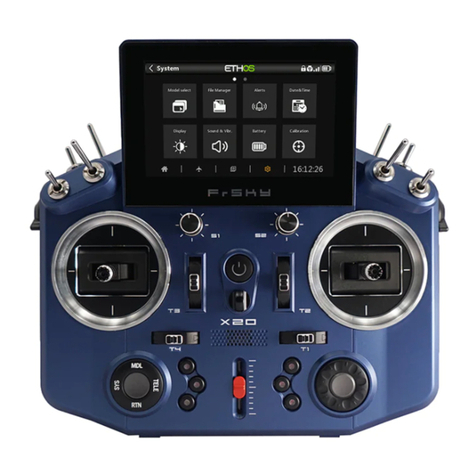
FrSky
FrSky TANDEM X20 Series User manual
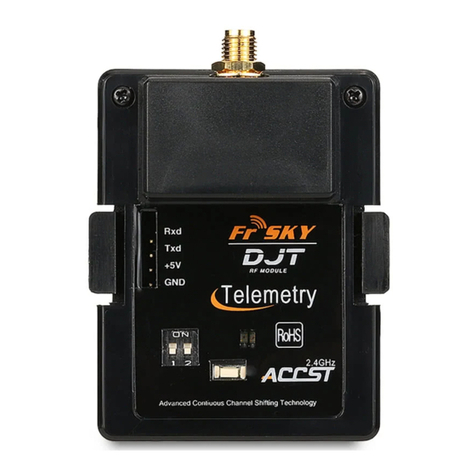
FrSky
FrSky DFT User manual

FrSky
FrSky RX6R User manual
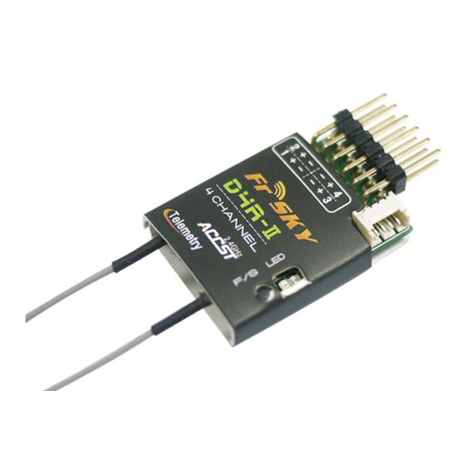
FrSky
FrSky D4R-II User manual
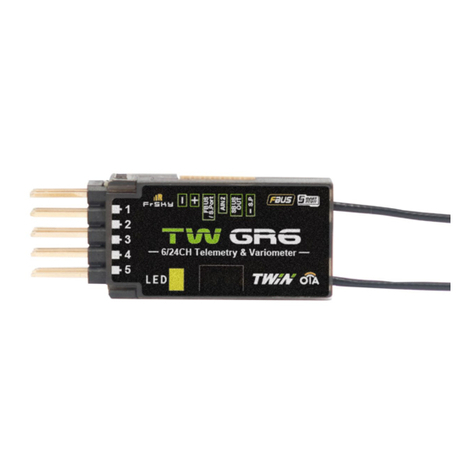
FrSky
FrSky TWIN Series User manual
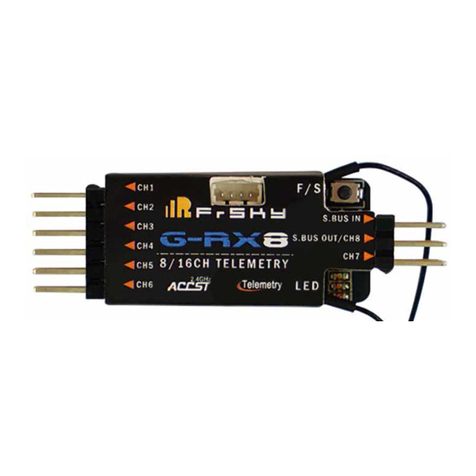
FrSky
FrSky ACCESS G-RX8 User manual
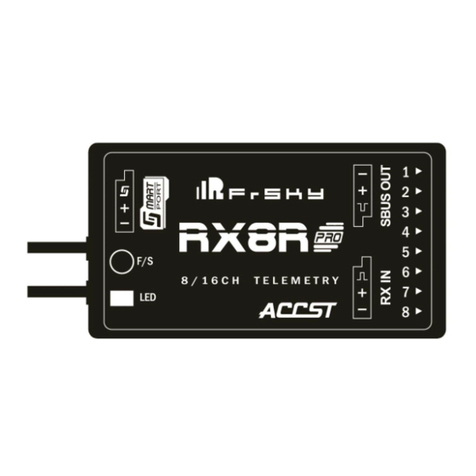
FrSky
FrSky RX8R PRO User manual
